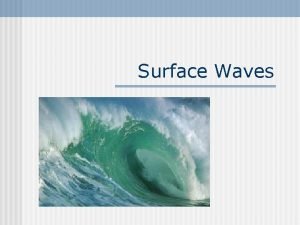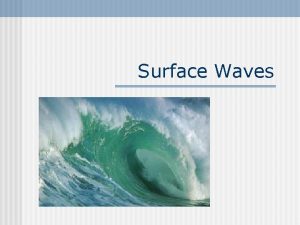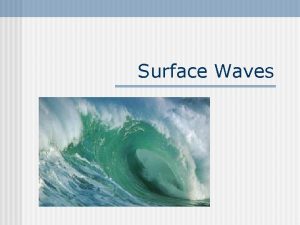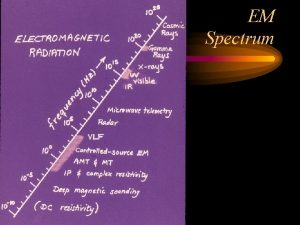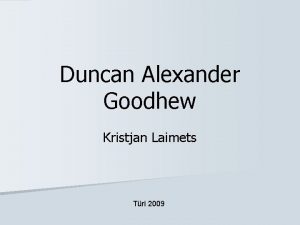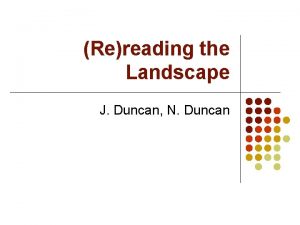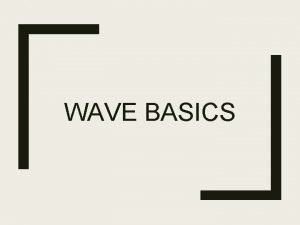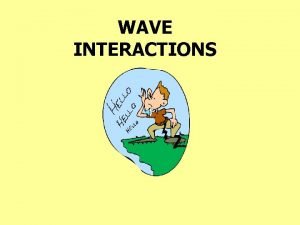CORF 204 Tom Evans Surface Wave Theory Duncan














![Water depth (1): Jones, D. (2015). Oceanography and meteorology. [lecture to FDSC year 2]. Water depth (1): Jones, D. (2015). Oceanography and meteorology. [lecture to FDSC year 2].](https://slidetodoc.com/presentation_image_h2/391dfab488f4ed5e5a75b15de5a0e0d7/image-15.jpg)

- Slides: 16

CORF 204 Tom Evans Surface Wave Theory Duncan Jones

Capillary Waves • Very small waves ( less than a few centimetres in wavelength) with the restoring factor of surface tension. • The wave has a round crest and a V- shaped trough. • Capillary waves are linear growth. (1) (2) Figure 1 (1): Britannica. (2015). Capillary waves. Oceanography. (Available online at) http: //www. britannica. com/EBchecked/topic/93834/capillary-wave. Accessed on the 14/ 04/ 15. (2): Jones, D. (2015). Oceanography and meteorology. [lecture to FDSC year 2]. February 10 th. Figure 1: Earthscience. (2010). Ocean waves styles and patterns. Capillary waves. (Available online at) http: //earthsci. org/processes/weather/waves/Waves. htm. Accessed on the 21/ 04/ 15.

Wave Generation • The flow of air over the surface causes different pressures to amount in different areas, this causes the waves to steepen. Energy is then transferred from the wind to the waves. • This process is effected by a number of factors, for example the speed of the wind, depth of water and the distance of open water. (1) (1): Brace, S. (2010). Wave Energy Generation. Wave formation and energy potential. (Available online at) http: //stevenbrace. co. uk/mecheng/final/. Accessed on the 17/ 04/ 15.

Gravity waves • Gravity waves are exponential growth. • The rough surface catches wind, this increases the size of the wave. (1, 2) Figure 1 • The wave shape then changes often due to change in depth causing random movement. • This can create larger vortices called turbulent eddies. • The restoring force is gravity. (2) (1, 2) (1): Britannica. (2015). Gravity wave. Water waves. (Available online at) http: //www. britannica. com/EBchecked/topic/242592/gravity-wave. Accessed on the 17/ 04/ 15. (2): Jones, D. (2015). Oceanography and meteorology. [lecture to FDSC year 2]. February 10 th. Figure 1: Evans, T. (2015)

Restoring forces – Gravity and Surface tension F=gd F: force per unit volume g: gravitational force per unit mass d: the density of the water or mass per unit volume (1) The hydrogen bond of water molecules causes them to be attracted to each over, therefore at the surface the water molecules will want to bond down and to the side with other water molecules. This results in the force acting to cause a minimal surface area flattening the surface. (2) (1): Scienceisart. (2015). Water, Waves and Ripples. Restoring forces. (Available online at) http: //www. scienceisart. com/B_Waves/Waves. html. Accessed on the 17/ 04/15. (2): USGS. (2014). Surface tension water. (Available online at) https: //water. usgs. gov/edu/surface-tension. html. Accessed on the 17/ 04/ 15.

Restoring forces - conversion forces • The same amount of water that moves from a region is brought in to a region, this restores equilibrium. (1) • Along with the forces shown in the diagram there is dissipative force, the eventual loss of energy from friction by movement. If the supply of energy (for example wind) would stop eventually the energy used in movement would too. (1) • As well as this there is the Coriolis effect produced by the movement of the earth around its axis. (2) (1): Scienceisart. (2015). Water, Waves and Ripples. Restoring forces. (Available online at) http: //www. scienceisart. com/B_Waves/Waves. html. Accessed on the 17/ 04/15. (2): Karleskint G. 1998. Introduction to marine biology. Harcourt Brace College Publishers. p. 378

Calculation of wave period • How ever if wind speeds, duration and fetch are known then a graph can be used to work out wave period. • F = period/ Frequency C = Wave speed (m/s) = Wavelength (m) (1) Study. (2015). Wave period: Definition, formula and quiz. (Available online at) http: //study. com/academy/lesson/wave-period-definition-formula-quiz. html. Accessed on the 23/ 04/ 15.

Celerity • Celerity is the velocity of the wave form not the water. • The water molecules will orbit while energy passes on. • As the wave increases in size so will the orbit of the water molecule. • Celerity is “The speed that a wave moves through the water”. (2) (1) (1): Jones, D. (2015). Oceanography and meteorology. [lecture to FDSC year 2]. February 10 th. (2): Cornwallguide. Cornwall surf forecast. Glossary of terms. (Available online at) http: //www. cornwalls. co. uk/surfing/surf-forecast. htm. Accessed on the 23/ 04/ 15.

Wavelength • A wave length is the distance between the peak of one wave and the next adjacent wave. • Here shown between the two crests, what are the heights points of the waves. • Figure 1 shows the gap between crests of waves, showing their wavelengths. (1) (2) Figure 1 (1): Thefreedictionary. (2015). Wavelengh. (Available online at) http: //www. thefreedictionary. com/wavelength. Accessed on the 17/ 04/ 15. (2): ONR. (2013). Ocean in motion. Waves – Characteristics. (Available online at) http: //www. onr. navy. mil/focus/ocean/motion/waves 1. htm. Accessed on the 17/ 04/ 15. Figure 1: Spinka, K, W. (2008). Wave math. (Available online at) http: //yale. edu/ynhti/curriculum/units/2008/5/08. 05. 06. x. html. Accessed on the 23/ 04/ 15.

Group speed For example the outer wave layer of a circle like in Figure 1, will be lost as a new ringed wave layer starts, the number of rings will then stay the same, the outside rings energy is lost in advancing the wave form. This results in the speed of individual waves in the group being greater than that of the wave ring on the edge. This means the outer ring will move out wards at a speed ½ of the individual inner waves. (1) • Group speed is the speed that energy is moved away from its original source under deep water conditions. (1) • This can be seen in the equation, where the speed of an individual wave is C. (1): Sverdrup, K; Duxbury, A, C; Duxbury, A, B. (2005). An introduction to the world oceans. 8 th edition. The Mc. Graw Hill companies. New York USA. Pp 253.

Wave patterns - Wave diffraction • A wide gap will equal a small diffraction. (1) • A narrow Gap will cause a larger diffraction. (1) • A large wave length with lead to a larger diffraction. (1) Figure 1 (1): Electron 6. (2009). Diffraction. Waves. (Available online at) http: //electron 6. phys. utk. edu/light/1/Diffraction. htm. Accessed on the 21/ 04/ 15. Figure 1: Google. Earth. Blog. (2012). Wave mechanics in google earth. (Available online at) http: //www. gearthblog. com/blog/archives/2012/01/wave_mechanics_in_google_earth. html. Accessed on the 21/ 04/ 15.

Wave patterns - Wave reflection • A wave is physically reflected of an object. (1) Figure 1 (1): Geocites. (2009). Reflection of waves. (Available online at) http: //www. oocities. org/wave 032002/reflection. htm. Accessed on the 21/ 04/ 15. Figure 1: Meted. (2015). Nearshore wave modelling. (Available online at) https: //www. google. co. uk/search? q=wave+reflection&source=lnms&tbm=isch&sa=X&ei=3 YA 2 Vf. C 8 LMm 4 a. Yf 6 g. Jg. N&ved=0 CAc. Q_AUo. AQ&biw=1366&bih=657#i mgrc=d. Kuyf_KA 8 x 3 GSM%253 A%3 BX 2 om 7 fpnkb. ATUM%3 Bhttp%253 A%252 Fwww. meted. ucar. edu%252 Foceans%252 Fnearshore_wave_models%252 Fm edia%252 Fgraphics%252 Fbreakwater_wave_reflection. jpg%3 Bhttp%253 A%252 Fwww. meted. ucar. edu%252 Foceans%252 Fnearshore_wave_models%252 Fprint. htm%3 B 607%3 B 400. accessed on the 21/ 04/ 15.

Wave patterns - Wave refraction • The depth of the wave approaching the headland starts to decrease, therefore wave height and steepness increases, while velocity decreases, the wavelength is no shorter. • While waves approaching the bay are in deeper water and therefore do not lower velocity as quickly, they are not as high and are less steep therefore the wave length is not shortened. (1) Figure 1 (1): Tripod. (2015). Waves and Tides. (Available online at) http: //members. tripod. com/Geography_homework/waves. html. Accessed on the 18/ 05/ 15. Figure 1: Coastalchange. (2013). Waves, Nearshore currents and Tides. (Available online at) http: //coastalchange. ucsd. edu/st 3_basics/waves. html. Accessed on the 21/ 04/ 15.

Wave interaction • Wave interaction occurs with waves that have left a storm, they can then pass through another wave in a similar circumstance moving a different speed in different directions. • The diagram shows how first waves approach each over. • If the waves coincide they then go in phase and the crest increases in height. • If the crest of one wave meets the trough of another the wave cancel and are out of phase. (1) Figure 1 shows two crests interacting to form a larger wave. Figure 1 (1) (1): Sverdrup, K; Duxbury, A, C; Duxbury, A, B. (2005). An introduction to the world oceans. 8 th edition. The Mc. Graw Hill companies. New York USA. Pp 253 -254. Figure 1: UPI. (2012). Wave action in tsunamis studied. Science news. (Available online at) http: //www. upi. com/Science_News/2012/09/19/Wave-action-intsunamis-studied/22151348090900/. Accessed on the 23/ 04/ 15.
![Water depth 1 Jones D 2015 Oceanography and meteorology lecture to FDSC year 2 Water depth (1): Jones, D. (2015). Oceanography and meteorology. [lecture to FDSC year 2].](https://slidetodoc.com/presentation_image_h2/391dfab488f4ed5e5a75b15de5a0e0d7/image-15.jpg)
Water depth (1): Jones, D. (2015). Oceanography and meteorology. [lecture to FDSC year 2]. February 10 th Figure 1: Earthobservatory. (2004). Measuring water depth from the international space station. (Available online at) http: //earthobservatory. nasa. gov/IOTD/view. php? id=4126. Accessed on the 23/ 04/ 15. • A deep water wave has a depth greater than half the wavelength. (1) • A transitional wave has a depth less than L/ 2 but greater than L/ 20. (1) • A shallow water wave has a depth less than L/ 20. (1) • Figure 1 shows the difference of deep and shallow water from space. Figure 1

Wave speed Below are the equations for different depths and wave speed: CD = Deep water wave speed CT = Transition zone wave speed CS = Shallow water wave speed • A wave is a disturbance to a medium. It can be seen by observing the crest move from one area to another. • The equation for speed is: (1) • If a wave moves at 10 meters per 10 seconds the speed is 1 meter/s. • If a wave is traveling at 1 meter/s then it will take 5 seconds for crest A to be where crest B is in the figure. (1) Thephysicsclassroom. (2015). The speed of a wave. (Available online at) http: //www. physicsclassroom. com/class/waves/Lesson-2/The. Speed-of-a-Wave. Accessed on the 22/ 04/ 15.
 Go 910
Go 910 Symbolism in the devil and tom walker
Symbolism in the devil and tom walker Sound waves are electromagnetic waves. true false
Sound waves are electromagnetic waves. true false Short wave vs long wave radiation
Short wave vs long wave radiation Difference between full wave and half wave rectifier
Difference between full wave and half wave rectifier Difference between transverse wave and longitudinal wave
Difference between transverse wave and longitudinal wave Examples of half wave rectifier
Examples of half wave rectifier Fullwave rectification
Fullwave rectification Earthquake p wave and swave travel time
Earthquake p wave and swave travel time Full wave rectified sine wave fourier series
Full wave rectified sine wave fourier series Longitudinal wave
Longitudinal wave The nature of waves chapter 10 section 1
The nature of waves chapter 10 section 1 Quarter wave symmetry
Quarter wave symmetry Electromagnetic and mechanical waves
Electromagnetic and mechanical waves What are the mechanical waves
What are the mechanical waves Wavelength formula triangle
Wavelength formula triangle Szpv 204
Szpv 204



















